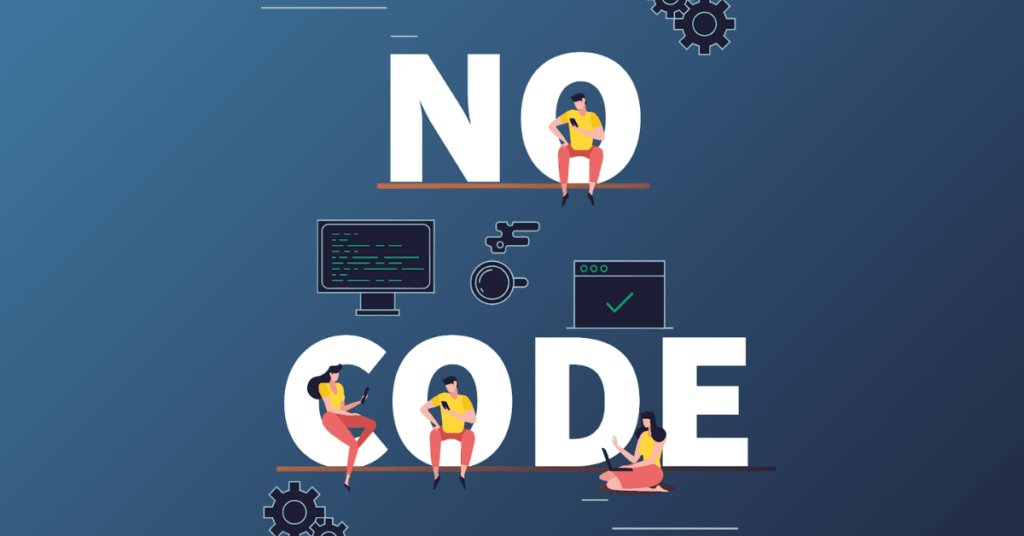Building software used to mean knowing how to code or hiring someone who could. But today, thanks to no-code development, anyone can create apps, websites , and tools without writing a single line of code. This exciting technology is changing how businesses and individuals bring their ideas to life.
No-code development platforms are simple and user-friendly , allowing people with no technical background to design and launch applications quickly. Let ’s dive into what no-code is, how it works, and why it’s making waves in the tech world.
No-Code Development
No-code development is a way to build software using visual tools like drag-and-drop interfaces instead of traditional programming. With no-code platforms, you don’t need to learn coding languages to create apps or websites.

These platforms provide pre-designed templates, elements and workflows that make it easy to customize your project. Popular no-code tools like Webflow, Bubble, and Airtable allow users to build anything from simple blogs to complex business solutions.
How Does No-Code Work?
No-code platforms simplify the development process with these core features;
- Drag-and-Drop Tools: Users can easily select and place elements like buttons, forms, or images on their project.
- Pre-Built Templates: Ready- made designs and structures help users start building quickly.
- Automated Workflows: Logic-based tools let users define how their app should behave, such as sending an email when someone submits a form.
- Integration: Many platforms connect with databases, APIs, or third-party apps to expand functionality.
This makes no-code development a fast, user-friendly option for creating software without coding skills.
Why Is No-Code So Popular?
No-code development is gaining attention because it solves common challenges in traditional software development:
1. Easy for Everyone
No-code makes app development accessible to anyone, whether you ’re a small business owner, an entrepreneur, or a student. You do n’t need to hire a developer or spend months learning to code.
2. Fast Results
What used to take weeks or months to build can now be done in hours or days. No-code platforms speed up the development process, helping users launch projects faster.
3. Saves Money
Developing software traditionally can be costly, especially if you need to hire a team of developers. No-code reduces these costs by allowing non-technical users to build their own solutions.
4. Flexible and Versatile
No-code platforms work for many different needs. You can create a simple website, an internal tool for your team, or even an app for your customers.
5. Encourages Creativity
With no technical barriers, people can bring their ideas to life more easily. This encourages experimentation and innovation.
Uses No-Code Development?
No-code tools are incredibly versatile. Here are some common use cases:
- Small Businesses: Create websites, e-commerce stores,or booking systems.
- Startups: Build a minimum viable product (MVP) to test an idea or attract investors.
- Large Companies: Develop internal tools , such as inventory management or employee portals.
- Marketing Teams: Design landing pages or automate email campaigns.
- Education: Build interactive learning tools or course platforms.
Benefits of No-Code Development
- Time-Saving: No-code tools help users create and launch apps quickly.
- Cost-Effective: You don ’t need to spend on developers or expensive tools.
- User-Friendly: The drag-and-drop interfaces make it easy for non-technical users to understand.
- Encourages Collaboration: Teams from different backgrounds can work together on the same platform.
- Rapid Updates: Changes or fixes can be implemented instantly without major rework,
Challenges of No-Code
While no-code is great for many scenarios, it does have some limitations;
- Scalability: Some no-code platforms may not handle very large or complex applications.
- Customization: Pre-built components might not cover highly specific needs.
- Performance Issues: No-code apps may run slower compared to custom- built software.
- Vendor Lock-In: Moving your project to another platform can be challenging.
Future of No-Code
No-code development is here to stay and is constantly improving. With advancements in technology, no-code platforms are becoming more powerful and solving many of their current limitations.
They are also complementing traditional coding rather than replacing it. Developers can use no-code tools for rapid prototyping while coding complex features as needed.
The future of no-code is bright. and as more people and businesses embrace it, we can expect even more creativity and innovation in the tech world.
No-code development is transforming the way software is built. By removing the need for coding, it opens doors for everyone to create apps and websites, regardless of their technical skills.
Whether you’re starting a new business, improving your team ’s workflow, or launching a creative idea, no-code platforms make the process faster, cheaper, and more accessible. The possibilities are endless, and the best part is—you don’t need to know how to code to get started!
Frequently Asked Questions(FAQs)
What is no-code development?
No-code development is a method of building software applications using visual tools and drag-and-drop interfaces, eliminating the need to write code. It allows users to create apps, websites, and other digital solutions without technical expertise.
How do no-code platforms work?
No-code platforms provide pre-built templates, design elements, and workflows. Users can drag and drop components, define logic and actions, and integrate external tools or databases to create functional applications.
What are some popular no-code platforms?
Popular no-code platforms include:
Webflow: For building websites.
Bubble: For creating web applications.
Airtable: For managing databases and workflows.How can businesses use no-code development?
Businesses can use no-code to:
Build websites and e-commerce stores.
Create internal tools like inventory management systems.
Launch marketing campaigns with landing pages and automated workflows.
Test new product ideas through MVPs (minimum viable products).What is the future of no-code development?
The future of no-code is promising, with continued advancements in features, scalability, and integration options. It’s becoming a key tool for innovation, making software development faster and more accessible to everyone.









